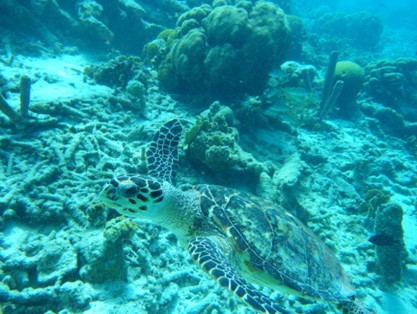Blog
1 Million Species May Become Extinct and What You and I Can Do About It
The United Nations released a Global Assessment Report on 6 May 2019 in Paris, a health check of our planet, if you will, compiled over three years by more than 450 scientists and diplomats. The message is stark: 1 million, out of the estimated 2.16 million of our planet’s plant and animal species are at risk of extinction, thanks to human activities. Many will be gone within decades unless action is taken.
Our Human Footprint
The report highlights how our human footprint is so large, it leaves little space for anything else: 75% of all land is being used for agriculture, covered by concrete, swallowed by dam reservoirs or otherwise significantly altered. 85% of the world’s wetlands have vanished since the 18th century. Two thirds of the marine environment have been changed by aqua culture, shipping routes, subsea mines etc. 75% of rivers and lakes are used for crop or livestock cultivation. As a result, more than 500,000 species do not have sufficient habitats for their survival. Many will disappear within decades.
Agriculture and fishing are the primary causes. Food production has increased since the 1970s, which has helped feed a burgeoning global population, generating jobs and economic growth. But this has come at a price: Grazing areas for cattle account for about 25% of the world’s ice-free land and more than 18% of global greenhouse gas emissions.
In contrast, crop production uses 12% of land and creates less than 7% of emissions.
In Indonesia, cutting down rainforest to make way for palm oil plantations has destroyed the habitat of critically endangered orangutans and Sumatran tigers. In Mozambique, ivory poachers helped kill nearly 7000 elephants between 2009 and 2011 alone.
Also, our waste is overwhelming the Earth’s capacity to absorb them. More than 80% of waste water is pumped into rivers, lakes and oceans without treatment, along with 300m to 400m tons of heavy metals, toxic slurry etc. Plastic waste has risen ten times since 1980, affecting 86% of marine turtles, 44% of seabirds and 43% of marine mammals.
Global Warming
At the same time, a new threat has emerged: global warming. Approximately 5% of species worldwide are threatened with climate-related extinction if global average temperatures rise 2 degrees Celsius above pre-industrial levels, the report. The world has already warmed by 1 degree. When populations are already small and losing genetic diversity, and landscapes are becoming fragmented, and when plants and animals can’t move to find more suitable habitats, we have a problem.
It is not just about the animals and the trees. This change in biodiversity will affect us all. Today, we are relying on significantly fewer varieties of plants and animals for food. Of the 6190 domesticated mammal breeds used in agriculture, more than 559 have become extinct and 1000 more are threatened. What this means is that the food system is becoming less resilient against diseases and pests. And it may become harder in the future to breed new, hardier crops and livestock to cope with global warming.
A radical re-think is necessary, according to the report’s authors. Piecemeal efforts to protect individual species are no longer be sufficient. “Transformative changes” are needed to curb wasteful consumption, reduce down agriculture’s environmental footprint and crack down on poachers and illegal logging and reducing the flow of heavy metals and untreated wastewater into the environment.
What Can We Do?
Three steps.
- As a first step, read up so you can keep yourself informed on the latest developments with regard to biodiversity and global warming. Friends who are environmental activists recommended the following two books: The Uninhabitable Earth: Life After Warming by David Wallace-Wells just published this year, and Drawdown: the Most Comprehensive Plan ever Proposed to Reverse Global Warming edited by Paul Hawken and published in 2017.
- Start at home. Reduce food waste. A 2011 report by the Food and Agriculture Organization(pdf document) estimated that the total global carbon footprint of food waste was equivalent to 3.6 billion tons of carbon.
Each year, the US, where I live, throws away nearly 40% of its food. 70% of water and 50% of land in the US is devoted to agriculture. So when we are chucking out food, it’s a tremendous waste of resources. About 33 million cars’ worth of greenhouse gases are produced to grow food that never gets eaten. According to the US Department of Agriculture(pdf document), that adds up to more than $160 billion wasted per year.
How can we reduce food wastage?
- Check the fridge first before going food shopping. You can throw leftovers together to make a stir fry, fried rice, smoothies, soups and/or casseroles.
- If you do need to go to the store, bring a shopping list and stick to it.
- Learn the difference between sell by, use by, best by and expiration dates. Don’t be afraid to buy less attractive, but still fresh produce.
- At restaurants, order only what you can eat. Take home the leftovers to eat another day.
- At buffets, put on your plate only what you can eat.
- Do a “food audit” for 2 weeks, noting down what kinds of food get thrown out.
- Vote for responsible politicians who are addressing the issue of climate change. We need to exert pressure on our respective local governments to make recycling and collection points more accessible, reduce carbon emissions, ensure that legislation is enforced including going after poachers, and adopt eco-friendly solutions where feasible.
Let’s all do our part to prevent the extinction of our planet’s species.
About the author:
Eirliani Abdul Rahman is the co-founder of YAKIN, an NGO working in the field of child rights and child protection issues and she continuously aims at raising awareness for survivors of sexual child abuse, the consequences of child labor and mental health issues.
Published on June 24, 2019.
Photo credit: Walter Copeland
